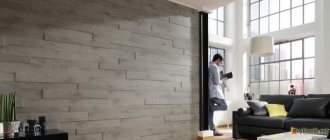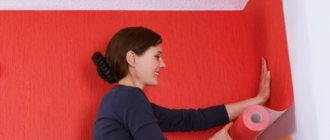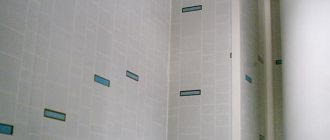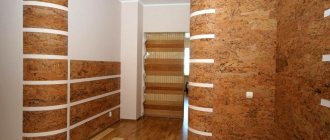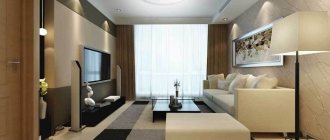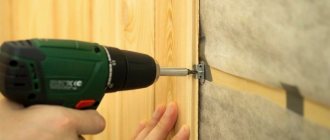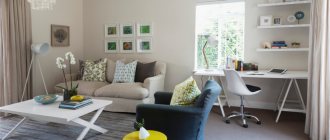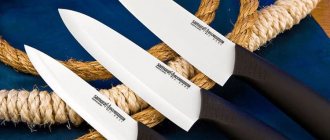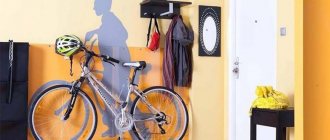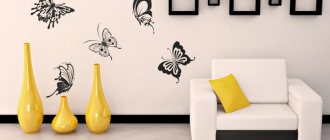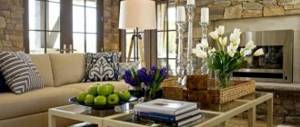When starting a renovation, you want it to be completed quickly and without a lot of cleaning. Alas, decorating walls with wallpaper or (as an option) decorative plaster does not end so easily: dirty scraps remain on the floor, traces of glue or building mixtures are everywhere. There’s a lot to worry about even before a renovation, because peeling off wallpaper is quite a troublesome task. Plaster, of course, can last much longer, but it can simply get boring after thirty or forty years. And removing it from the wall is probably even more difficult. In this case, covering the walls with MDF panels may be the best option. They are not only easy to install; With the help of this material you can solve other problems. Which ones - we'll say further.
MDF panels: what is it?
Many people believe that MDF is just an imitation of wood. You could say that too. In fact, the characteristics of the material are the same as those of wood. Why? It's simple: wood waste is used as raw material. Sometimes MDF panels are confused with fiberboard and chipboard, although their manufacturing technology is different. The method of dry hot pressing is used here, which makes it possible to do without a chemical binder like phenol: wood fibers are connected to each other under the influence of temperature and pressure.
To understand why it is worth finishing walls with such material, just look at its advantages. And they are like this:
- environmental friendliness. As mentioned, no chemicals are used in production. Therefore, interior wall decoration with MDF panels will not cause harm to health;
- cheapness. The slabs are cheaper than, for example, lining, although they are not inferior to it;
- the ability to hide communications (which you can’t do with the same wallpaper);
- no finishing required. If the drywall needs to be painted, painted or pasted over, then installation is sufficient;
- having the same characteristics as wood. At the same time, as was said, the price of MDF is more affordable.
Now (to be fair) let’s look at the disadvantages:
- flammability. Wood is known to ignite well. However, if you choose between lining and MDF, then there is no difference;
- fragility. If a heavy object flies towards the wall, the wall will probably be damaged.
Kinds
In fact, all panels are the same, since they are made using the same technology. The difference lies only in their external decoration. According to this type, panels are divided into:
- laminated. This type is the most common. The sheets are covered with a polymer film using the pressing method. One of the advantages of this finish is a wide range in terms of appearance. With the help of the finishing material, the slabs acquire a wide variety of textures: for example, they can imitate not only wood, but also stone, tile, etc. A wall finished with such panels is easy to care for: just wash the surface. In addition, this particular type is the cheapest;
- veneered. Unlike the previous analogue, this one costs the most. The finishing is done with natural wood veneer, which can be glued on one or both sides. Such boards are resistant to moisture, warping, and drying out. In addition, they have a solid appearance. But such slabs are used infrequently, precisely because of their cost;
- painted. This option is very popular among furniture makers, although walls are also decorated with them. The material is painted with special compounds (for example, enamel) manually or using automatic machines. Such panels also allow you to choose something that suits your beauty best, since they come in many different shades.
Each of these types has its own advantages. For example, a veneered analogue has greater resistance to mechanical damage. But still, laminated panels are more often chosen: they are inexpensive and easier to clean.
Size
Above, the panels have been called either sheets or slabs more than once. In fact, these are not synonyms. Panels is a common name. But depending on their size they are divided into:
- rack and pinion Long and narrow, in appearance they resemble clapboard. By the way, for those who like this very lining not only for its characteristics, but also for its size, these panels are perfect. They can be mounted both vertically and horizontally;
- tiled. Actually, the name here also speaks for itself: such panels are produced in the form of squares or rectangles. It is good to make beautiful patterns with such fragments;
- leafy. These panels are quite impressive in size. They can be selected in height so that one sheet is enough from floor to ceiling. The joints between the panels are designed as finishing. This option is suitable for owners of bathrooms with a large square footage.
Shades of different colors and textures
A great advantage is the wide choice of shade and texture of panel patterns. In most cases, the pattern imitates different types of wood.
MDF wall panels are made using the same technology, but the surface of such products may have different finishes. In this regard, the materials under consideration can be divided into several varieties:
- Veneered. In this case, natural veneer is used as a decorative finish. Thanks to this coating, the product’s appearance resembles natural solid wood and has the highest cost among its analogues.
- Laminated panels are considered one of the most popular designs. The simplest option for making such products is considered to be gluing the surface with melamine film. This material usually imitates the structure of wood and is used to decorate walls. In some products, during lamination, a high-gloss film may be glued to the surface, improving the appearance of the material. Such panels look exclusive and respectable.
- The corridor can be finished using painted MDF panels. Here, a decorative coating is considered a layer of paint instead of simulating wood texture.
See also: Moisture-resistant drywall - characteristics and application
The products in question can be used for cladding any of the rooms of the apartment with the exception of the bathroom. The surface of such products differs significantly from the unnatural appearance of plastic. The end consumer can choose an acceptable design and size of the product for himself, paying relatively little money for building materials.
Now let’s pay attention to the dimensions of the product:
- The standard slab length is considered to be 2.6 meters, although the dimensions of some materials may differ up or down - 2.4 or 2.7 meters, respectively.
- The width of the panel also varies within significant limits, for example, an MDF plinth has a width of 15 centimeters, while the parameters of a conventional plate are within 90 centimeters, for some products 1.2 meters. The width of the material greatly influences its aesthetic functions. As this parameter increases, a person notices the presence of vertical seams, which further emphasize the texture of the product.
- Depending on the final purpose, the thickness of the panel ranges from 3 millimeters to 3 centimeters. For veneered materials, this figure can reach up to 6 centimeters.
When choosing decorating elements, you must remember that the thinnest parts have minimal strength indicators, so they are used to decorate walls. Materials with a thickness of more than 1.2 centimeters are often used as an additional heat-insulating layer. In terms of properties, such insulation replaces a brick wall 15 centimeters thick.
How to attach MDF panels to the wall
There are two ways to attach panels to the wall: adhesive and frame. In the first case, the sheets are simply glued to the surface; in the second, a sheathing (that is, a frame) is assembled from wooden slats or a metal profile.
Each method has both pros and cons. Thus, using only glue allows you to finish walls easier and faster. True, this technology is only possible with smooth and dry walls. But, if it is possible, the area of the room remains the same, which is very important for many. There is also less chance of damaging the material during installation.
In the case of the frame method, you will have to tinker a little. In order to assemble the sheathing, you need both skills and time. It is easier to damage the panels during installation here, since self-tapping screws (or small nails) are used. You also need to be prepared to reduce the area that the width of the frame takes up. Difficulties also arise with hanging various objects (decorative or furniture), especially if they are heavy.
But still, the frame method has more strengths than weaknesses. So, if the walls are uneven or damp, it is irreplaceable. It is worth saying that in this case the panels outperform many other finishing materials, since they hide all these defects. Also, in this way, various communication systems can be removed. In addition, the space between the wall and the panels can be filled with insulation. Well, and finally, the frame option is suitable for those whose walls have poor sound insulation (for example, residents of some apartment buildings).
Wall decoration with MDF panels
On glue
The first important point in this matter is the correct choice of glue. To begin with, each specific composition is intended for a specific material (or group). Taking a package from the shelf, look on it for a list of what this glue is used for. There are also universal analogues, but they do not always correspond to the declared characteristics. It is best to first ask which adhesives are best suited for MDF panels, and then look for them. Here are the requirements to help you make the right choice:
- absence of unacceptable toxicity (after all, after finishing, people will live in the room);
- resistance to moisture and temperature changes;
- sufficient adhesive strength.
So, we bought the glue. But this is still not enough to start work. The wall must be ready for them, and torn off old finishing is not enough here. So, the surface needs to be degreased, dirt removed from it, and leveled (after all, panels cannot be glued to an uneven wall). Now you can begin the main work.
The glue is applied to the back surface of the panel in two ways: dotted (only in large drops) or wavy. Now you need to wait a little (you need to look at the package for the exact time). Then the panel should be applied to the wall and knocked on it - for example, with a rubber mallet or just with your fist. For some time (depending on the glue) the element can be adjusted; then polymerization and cooling of the glue occurs. By the way, excess also needs to be removed quickly, while this can be done more safely (for example, with rags). Then they will have to be cut with a sharp knife, but so as not to damage the surface of the panel (and this, you see, is more difficult than simply wiping it off).
In addition to glue, other compounds are also used: for example, liquid nails or polyurethane foam. The last work is more difficult to carry out, since it tends to increase in volume. True, you also need to work with adhesives carefully. So, it is better to provide a flow of fresh air in the room (it’s good if there is ventilation). You also need to make sure that the glue does not get on the skin. If this happens, it must be washed off with water and the skin area treated in accordance with all medical requirements.
On the frame
As already mentioned, this method has more positive aspects than the previous one. For example, you don't need to bother with wall alignment. However, this is of little consolation: there will be even more work here, because in any case it is necessary to assemble the frame. And this already requires time, knowledge, and skills.
Wooden beams, metal strips or profiles are suitable as materials for sheathing. The first option is, of course, more attractive: wood costs less and is easier to drill. But this is only at first glance. So, the timber needs to be prepared by saturating it with all the necessary substances. Otherwise, the frame may rot or catch fire. When buying timber, you need to inquire about its humidity: it should not exceed 15%.
If in the previous case the glue was the connector, then in this case the MDF panels are fastened to the wall using self-tapping screws, hangers and a screwdriver. Here's what you should pay attention to:
- Before attaching the elements, you need to mark the wall. But even after the beam or profile is fixed, the elements must be checked using a level;
- slatted panels can be mounted both horizontally and vertically. The main profile must be attached perpendicularly. Therefore, you need to decide on the direction of the panels before assembling the frame;
- the wires must be insulated (especially if ceiling work is being carried out). Otherwise, a spark may cause a fire (after all, the panels are wooden);
- when designing a frame, you need to take into account the insulation: its presence or absence, dimensions, etc.;
- before installation, you need to decide on the lamps and switches and make the appropriate holes in the panels;
- Don’t forget about windows and doors: guides should also be installed along their edges;
- the panels must be installed carefully so as not to damage them during drilling;
- The first panel must be installed as level as possible, otherwise the entire finish will be skewed.
Well, and, of course, in both methods you should not forget about safety precautions. So, to the desired size, the panels can be cut with a jigsaw or a circular saw (although, for example, slatted panels can be easily cut with a hacksaw). Work must be carried out carefully so as not to harm yourself - this is more important than maintaining the integrity of the finishing material.
Technology of cladding walls and ceilings with MDF panels
As mentioned earlier, all work on cladding walls and ceilings with MDF panels is almost identical to finishing with clapboard. When choosing the facing material itself, it is recommended to give preference to German MDF panels, since Germany is one of the leading countries in the sector of production of high-quality finishing materials. The principle of finishing is fully explained in the video added to this lesson, and the technology comes down to carefully attaching the decorative coating to wooden blocks pre-installed on the surface of the walls and ceilings, which are located perpendicular to the MDF panels with a certain pitch.
So, after preparing wooden blocks of the required cross-section, work on covering surfaces with decorative MDF panels should be carried out in the following order:
- the direction of laying the panels on the sheathing is determined;
- perpendicular to this direction, wooden sheathing bars are attached to the walls and ceilings, and the lowest one should be 3 - 5 cm from the floor level and the top one at the same distance from the ceiling, and the distance between these bars must be divided into several equal parts and the intermediate bars should be attached with in steps of 40 - 50 cm;
- before final fixation of the sheathing, it is necessary to check the verticality of its fastening and, in case of deviations, level the sheathing by placing pieces of laminate, wooden wedges or pieces of other solid materials under the bars;
- on both sides, where the first and last MDF panels will be located, you also need to fasten the bars, which should run in the corners perpendicular to the pre-fixed sheathing;
- when fastening the panels vertically, they are laid in the direction from right to left, starting from the corner, and the first MDF strip is attached to the corner bar with self-tapping screws along the entire length at a distance as close as possible from the corner, so that they can then be carefully covered with decorative corner strips;
- on the groove side, the first MDF panel is attached to the sheathing with staplers or small nails with wide heads;
- by inserting the ridge into the groove, all the other panels are fastened with your own hands in the same way, and the last panel in the corner is fixed in the same way as the first, to the corner bar along the entire length with self-tapping screws;
- In the corners where the self-tapping screws for fastening the outer panels are visible, special decorative MDF corners are glued, which are purchased along with the panels.
Finally, I would like to draw attention to several important nuances that are not visible in the photo and are not explained in the video. In order to attach hanging furniture or just a hanger to such a finish in the future, you will have to use special long dowels or anchor bolts, which must go a sufficient distance into the wall under the MDF panels. It is also necessary to recall that MDF does not withstand impacts from sharp objects. And although the panel can always be dismantled by disassembling part of the covering and attaching it back, it is better to avoid damage.
However, despite their relative fragility, MDF panels today create serious competition in the construction market for materials such as drywall, ceramic tiles and wallpaper, the finishing of which requires much more time and is more complex in terms of craftsmanship. Good luck with your renovation!
Let's sum it up
This is a brief overview of MDF wall panels. To make the picture more or less clear, let’s summarize what has been said into several points:
- panels have their advantages and disadvantages. So, installation is carried out faster than, for example, plastering. At the same time, they are fragile and can catch fire;
- It's very easy to find something that fits your size. So, you can choose slats that are similar to lining, which, moreover, are cheaper;
- The finish of the panels also varies. As a rule, the choice is laminated, but other options also have their own attractiveness;
- installation can be carried out in two ways: with glue and with a frame. The first option is simpler, but requires smooth and dry walls. The second is more labor- and time-consuming, but allows you to hide uneven surfaces (which may not be dry), as well as wiring and pipes. You can also lay insulation between the guides;
- all work must be carried out in accordance with calculations. So, the guides must be attached evenly and in the desired direction (vertically or horizontally), and the first panel must also be even;
- Installation of MDF panels must be carried out carefully so as not to damage either the finishing material or, especially, yourself.
If you have enough knowledge and skills, you can begin installation yourself. If not, it is better to trust the specialists: in this case, not more, but less money will be spent, since the chances of redoing the work are significantly reduced. And properly executed finishing is the key to long and high-quality service, which creates not only a beautiful appearance, but also comfort in the house.
Advantages and disadvantages
When choosing any building material, users take into account its strengths and weaknesses. First, let's get acquainted with the advantages that wall panels have. These include:
- Availability of material on the construction market.
- Relatively low price. The cost per square meter of high-quality coating from the most famous manufacturers can range from 5 to 12 dollars, while the specified product is used not only to level the surface of the wall, but also as a decorative element.
- Another positive quality of MDF boards is the ability to install them yourself without the help of a specialist. Such work is characterized by a high installation speed, although the maximum amount of time is spent on constructing the frame.
- Installation of panels can be carried out on the surface of walls and ceilings; you can even cope with such work alone.
- The products have a presentable appearance. Most materials imitate the surface of wood, but their pattern may be the same. In this regard, it is necessary to avoid using MDF panels over large areas.
- The materials under consideration can be used as an additional heat-insulating and sound-proofing layer, and especially if the cladding and base surface have an air gap.
See also: How to putty drywall
Flaws:
- Low strength indicators of the material, this is especially typical for slabs of small thickness.
- Limitation in the choice of colors and textures of panels.
- Reducing the usable space in a room by making a frame and installing panels.
- Low fire resistance. As we have already said, this material is made from wood, and wood is subject to combustion when exposed to high temperatures.
- The material has low water resistance; its structure can be destroyed even under the influence of condensation when the panels are installed on an insulated balcony or loggia.
